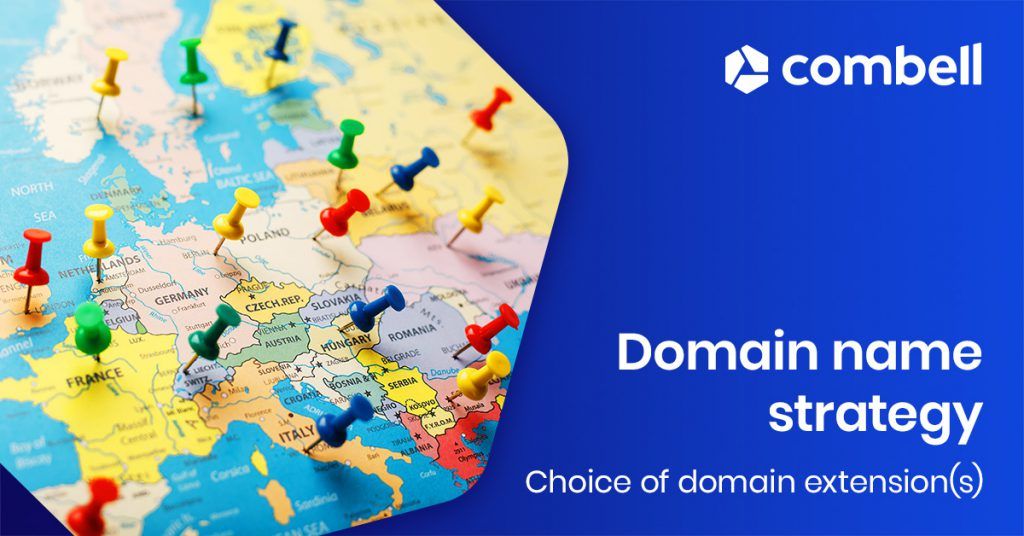What is the best domain name strategy?

You want to get your business online. And you are thinking about the future – the international market is your final goal. What is the best domain name strategy when choosing the right domain extension? Will you go for a single generic domain name for all countries or will you pick different domain names for each country? Here are a few tips.
Your domain name is the foundation of your business – offline as well!

Even if your business does not offer products or services online – just think of the self-employed such as bakers, butchers, plumbers, etc. – you still need to have your own website. Your (future) customers must be able to find you, contact you by e-mail or telephone, and know what products or services you offer and what your opening hours are.
The very foundation of your website is your domain name. That is the most important thing, because your customers must be able to find you. Your domain name should therefore be easy to remember and not subject to misinterpretation – for instance, avoid using hyphens. In our articles "Coming up with the right company name using a name generator" and "8 handy tips to choose a good domain name", we give you quite a few tips to help you choose a catchy company name and the corresponding domain name.
At home or abroad: finding the right domain name strategy is key
A very important factor to consider when choosing your domain name is your target audience. Is your focus exclusively on the domestic market, or do you want to go international? And in the latter case, are you only interested in certain countries or is worldwide presence a priority?
Those choices you will make as part of your domain name strategy will help you choose your domain extension:
- For a worldwide target audience, we recommend a 'generic' top-level domain (gTLD) such as .com, .online, .shop, .immo, etc. (click here for a full list of possibilities).
- Conversely, if you are targeting a specific country, you should pick a country code top-level domain (ccTLD) like .be, .nl or .fr.
- Or maybe a .eu domain name could be a good way to let people know that you want to serve customers from all over Europe. You can also read: "Is the .eu domain extension the safest choice?"
- You may also want to combine different solutions: you can choose a generic domain, like www.domain.com for example, and create different versions for each country, like www.domain.com/be or be.domain.com.
But what is the smartest strategy? What is the most profitable, not only financially, but also from Mr. Google's perspective – in other words, SEO-wise? Let us take a look at the many options available, with their respective pros and cons.
1. One domain per country
A domain name with the extension of the country you are targeting has one major advantage: it is ideal for SEO (Search Engine Optimisation). Google knows that when you are looking for a baker, there is no point in showing you addresses from the other end of the world. Instead, Google will show you with a list of bakers from your own country. And thanks to geolocalisation, Google can even know your exact location and show you bakers near you. Using a domain name with a ccTLD, combined with a name in the language of the corresponding country, is the best way to let Google know that your company is active in that country. So, this will help you rank higher in search engines.
Furthermore, a domain name with a country code extension will help build trust with users in that country. They will expect a better delivery and return service, a better customer service, etc.
There are, however, a few minor drawbacks:
- This option involves much work: you have to create a separate website for each country where you want to be represented, with country-specific content, and that will cost you a lot of time and money. But if you are willing to accept that, this is a highly effective strategy.
- Availability: your domain name must be available for all the desired ccTLDs. Because it is always preferable to use the same name (your brand) for all extensions in these countries. Is your domain name already taken in one of those countries? The tips we give you in our article "Help! My domain name is taken… Now what?" will help you find a solution to your problem.
Impact on SEO: a country code TLD will help you rank very high in local search engines. But the search engine will see each domain as a separate website, with its own value.
Using a domain name with a ccTLD, combined with a name in the language of the corresponding country, is the best way to let Google know that your company is active in that country.
2. Adding folders to your main domain
Another possible domain name strategy involves working with folders or subdirectories for a generic extension (gTLD). On your hosting, you create a folder, in which you put the content for a target group. That is very convenient, because you can use such a folder to indicate the country or the language. So, www.mydomain.com/nl, for instance, can be used for the Dutch version, /fr the French version, /eng the English version, and so on.
You can, however, create such a folder for each country. This is especially useful when you are selling products or services for which different rules and obligations vary from country to country. Bear in mind that, for some countries where people speak different languages, you should also take those languages into account. For Belgium, for example, you should create a /be-nl and a /be-fr subdirectory (or /be/nl and /be/fr). The same goes for Canada, where English and French are spoken, and for Switzerland you have to create Italian, French and German versions.
Impact on SEO: the value of all folders is centralised in your domain. So, the value all countries get is assigned to the main domain. In other words, if a backlink points to domain.com/en/, it is the main domain (domain.com) that will benefit from this backlink. However, this method is especially recommended for large companies with more than 10,000 monthly visitors.
For smaller companies, it is much more difficult to rank high in local search engines using subdirectories. This method is therefore only recommended if they are not dependent on search engines to attract new visitors to their website.
3. Adding subdomains to your main domain
However, a generic domain name (gTLD) also enables you to work with subdomains. You can e.g. create de.domain.com for Germany and nl.domain.com for the Netherlands. You will then be able to present country-specific content on each of these subdomains.
Impact on SEO: Subdomains tend to rank lower in local search engines than domains with a country code extension (ccTLD). Google, however, does not show any preference, and you can determine which languages and countries your website is focused on – for each subdomain.
But this option is only useful when a certain country code extension is no longer available for your domain, or when you cannot (or do not want to) roll out an extended network in the corresponding country.
Attention: you cannot use this method if you also use subdomains for other purposes, like https://help.domain.com – in that case, you should use subdirectories (folders).
Country code extensions, subdomains or folders: what is your best option?

This is usually a good rule of thumb for a good domain name strategy:
- You are aiming for the world: you have a standardised product, a digital service, which you can sell all over the world. Use a generic domain (.com or one of the new domain extensions) on which you can put the English version. Large companies can also register domain names with those specific country code extensions for the different countries in which they operate and then redirect users who visit this domain to the main domain. For SMEs, this option would require too much work, meaning that working with subdirectories, in which they will present country-specific content, is a better solution.
- You are only interested in a few countries: register your domain with the country code extensions for those countries in which your target audience is located. And make sure you do not forget about the existence of the .eu extension!
- You do have international ambitions, but want to focus on certain countries: create separate websites for these countries, with a country code extension. For the other countries, provide a translation of your website in a subdirectory. If, at a later stage, you start working actively in another country, you can just move that subdirectory to the country-specific domain. In this case, however, it is important that you register your domain name with as many country code extensions as possible right from the start.
Some extra tips for your domain name strategy
- Tip 1: use the 'hreflang' tag to let Google know which version of a page should be displayed to the user. Follow the instructions provided by Google.
- Tip 2: it is extremely important that you start thinking about your domain name strategy well in advance. If you have to change your URL after a few years, you may lose all your organic traffic. And all backlinks will have to be redirected to your new website using a 301 redirect. So, our advice is: it is better to register a domain too much than too little – the mere cost of annual registration can save you a lot of trouble in the long run. Do not compromise your international expansion!
- Tip 3: centralise the domains you register. Combell helps you manage all your domain names centrally with great ease. You can adjust all the settings yourself, create redirections, configure your e-mail and so forth. Plus, you get 10 services for free! Are your domains registered with another provider (or with multiple providers)? We can help you transfer them! With Combell, you will be able to choose from more than 1,000 domain extensions.
Are your (international) domain names still available?


